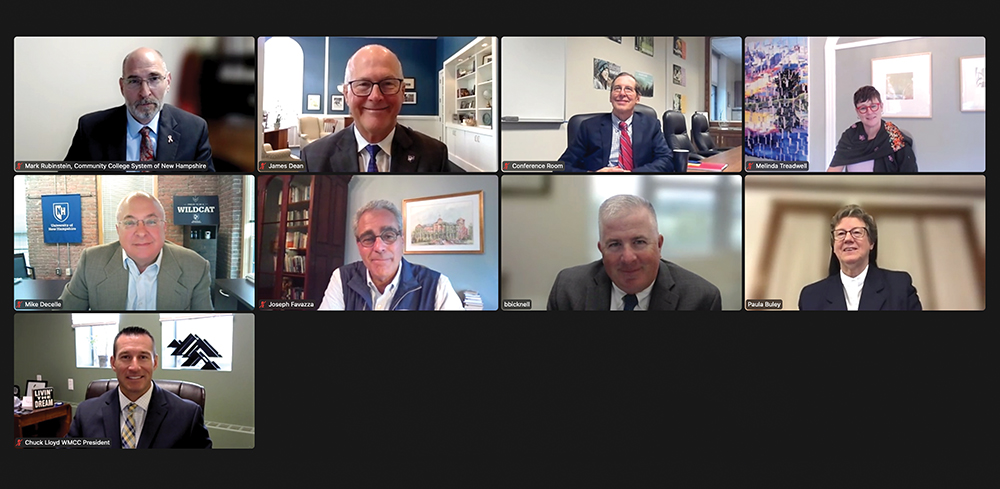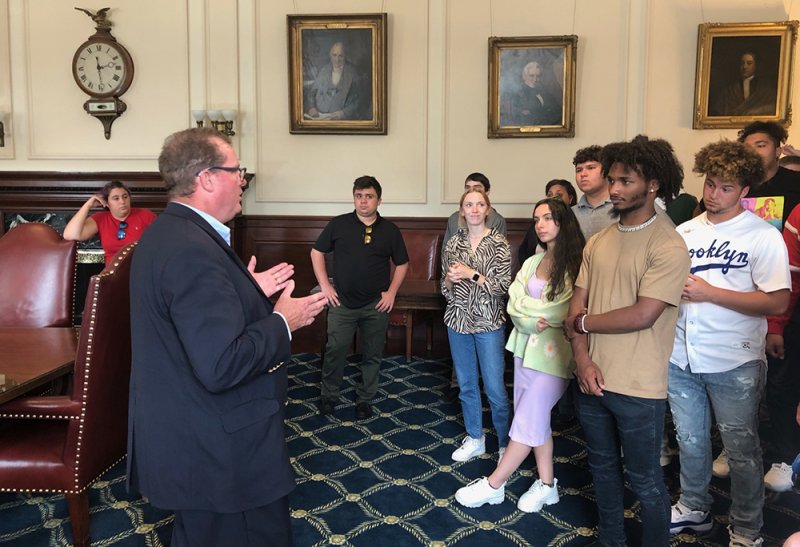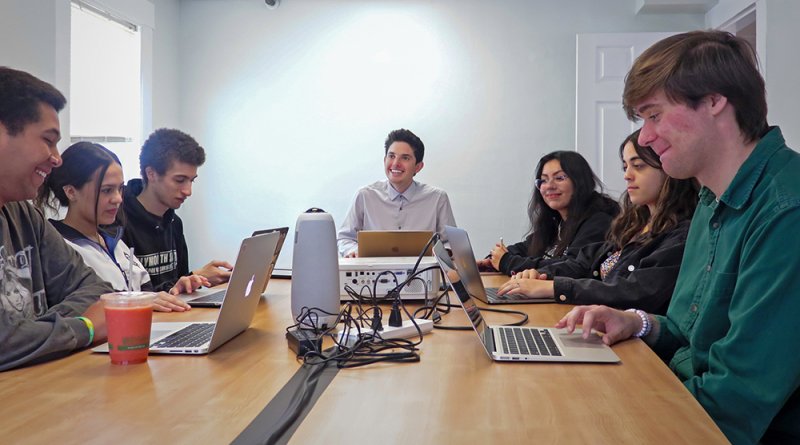
Top row, from left: Mark Rubinstein, chancellor, Community College System of NH; James W. Dean Jr., president, University of NH; Donald L. Birx, president, Plymouth State University; and Melinda Treadwell, Keene State College. Middle Row, from left: Michael Decelle, dean, University of NH Manchester and Granite State College; Joseph Favazza, president, Saint Anselm College; Brian Bicknell, president, Manchester Community College; and Sister Paula Marie Buley, president, Rivier University. Bottom Row: Charles Lloyd, president, White Mountains Community College.
Students are feeling the economic squeeze of high inflation and high housing costs, which have compounded the economic pain felt by some during the pandemic. The economy may force students to rethink their education plans, and colleges and universities are examining ways to make sure they don’t lose those potential students.
For a deeper understanding of the trends and issues facing higher education, Business NH Magazine held a virtual roundtable conversation with presidents of NH colleges and universities in late June.
While not a participant in the discussion, Dartmouth College in Hanover recently announced it was eliminating student loans from its financial packages and replacing them with scholarship grants.
It’s a move that has caught the eye of many higher education leaders. “A little bit of dollars makes a huge difference,” says Dr. Donald L. Birx, president of Plymouth State University (PSU). “We would all have more students if we could afford to provide more scholarship funding.”
He adds the pressure on students and families is particularly hard in northern NH, which was affected by the initial COVID-related tourism drop off. “The biggest question is always, ‘Can I afford to go?’ We work very hard to deal with it, but it is getting more challenging every day.”
At Saint Anselm College in Goffstown, President Joseph Favazza says they are increasing the hourly rates for work-study students. “COVID forced us to re-examine all of our policies, such as withholding transcripts if money is owed,” he says. “We are trying to be much more transparent and student-focused and ask if policies are really helping students.”
At the state’s flagship university, James W. Dean Jr., president of the University of NH (UNH) and interim chancellor of University System of NH (USNH), says families at the lowest end of the economic spectrum are really suffering.
“When we think about student retention, our minds go first to academic issues, but in the past few years economic issues have loomed just as large. Many of us now have programs to help with food and even places to stay as some of our students are literally homeless,” says Dean, adding across USNH’s institutions, students below a certain economic threshold don’t pay tuition.
Just prior to the pandemic, UNH established a student basic needs initiative that provides grants. “A student may need $300 to get a car repaired,” Dean says. “If they don’t get the car fixed, they don’t get to class, they don’t graduate. They then lose out for a lifetime on the benefits of higher education. We’ve made investments to make sure students don’t get derailed.”
Normally when the economy falters, more people turn to colleges, particularly to community colleges, to hone their skills or course correct their careers, but the pandemic is far from normal, says Community College System of NH (CCSNH) Chancellor Mark Rubinstein.
“In 2008 and 2009, with the housing crash and the Great Recession, a swell of working adults pushed out of the labor market went back to college to retool. That didn’t happen in the pandemic,” he says. “In addition to being displaced from jobs, a lot of people found child care was disrupted, the education of their children was disrupted, so the ability to use education to retool wasn’t there.”
Rubinstein says there has also been a downturn in students filing FAFSA applications (Free Application for Federal Student Aid) and an even sharper downturn in Pell-eligible students. Higher wages are locking them out. Often, they find themselves on the cusp where they are not quite needy enough to be eligible for assistance but without the resources to make college viable.
CCSNH, which is made up of seven colleges across the state, has seen its sharpest downturn in enrollment over the past several years, mirroring a national trend. “Often it is because our students are the most vulnerable,” says Rubinstein. “It’s a cross-section that includes traditional-aged students, but we also serve a lot of working adults and based on the circumstances, the child care pressure and employer demands to work more hours, they cannot fit education in.”
Manchester Community College President Brian Bicknell says many students were experiencing financial challenges before the pandemic, which inspired the college to introduce cost-saving measures, such as shifting to online resources to replace expensive academic texts. “This past summer session, we had more students struggling to pay their tuition than any other summer session since I’ve been here. A little bit goes a long way. It wasn’t like they owed five grand; it was more like $750. We’ve been trying to do some fundraising for scholarships to help out.”
Charles Lloyd, president of White Mountains Community College (WMCC) in Berlin, says students are looking to colleges to make earning a degree more affordable. “We offer dual and concurrent enrollment in the high school that saves on the front end and work with our four-year transfer partners to make sure all the credits transfer. It really saves on the total cost of a degree,” he says.
The college also offers the “Meals IncludED” program that provides free breakfast and lunch, giving students one less stressor to worry about, Lloyd says. The college is now partnering with Tri-County CAP to provide free bus rides in the northern three counties.
COVID Changes Persist
Many COVID-inspired changes are here to stay, as colleges reinvent the on-campus and online—synchronous and asynchronous—experience and approaches to teaching.
“We tended to bifurcate our academic programs whether on ground or remote,” says Sister Paula Marie Buley, president of Rivier University in Nashua, but that is no longer the case. And the hybrid approach allows the university to rethink how it allocates space for classrooms, student collaboration and academic offices, she says.

A hybrid of in-person and remote learning at Rivier University. (Courtesy photo)
Michael Decelle, dean of the University of NH Manchester and Granite State College, says UNH Manchester has historically operated as a commuter campus but with an emphasis on traditional classroom experiences. Pre-COVID, the percentage of students taking online classes was in the single digits but has since shot up to about 25% to 30%.

Students working in the library at UNH Manchester. (Courtesy photo)
“COVID taught us we were underserving our commuter students, who tend to work part or full time and have family obligations, and that a greater portion of online delivery was necessary to maintain and keep those students engaged,” Decelle says.
Offering more hybrid and online options made it possible for Saint Anselm College to give its students flexibility. “Even though we have always been a traditionally high-touch institution, we realize we must meet students where they are and be cognizant of the digital divide. We have given out computers, done what we need to make it accessible,” Favazza says.
Melinda Treadwell, president of Keene State College, says by necessity classes moved to an online delivery model as students are still seeking flexibility in accessing learning. “The investments we’ve made will give us the capacity to mashup or unbundle how we are delivering education and give more flexibility to multiple types of learners. But I also see a resurgence in the students’ desire to be in the community, on campus and in the classroom with faculty and their peers,” she says.
Mental Health Needs Increase
Demand for mental health services on campuses was already on the rise prior to COVID, and the pandemic exacerbated that need. Colleges and universities across NH provided access to telehealth during the pandemic, which also expanded the hours when students could find support.
Treadwell says global uncertainties are amplifying existing anxiety and depression caused by the pandemic and social separation. “A new normal requires more investment in mental health and wellbeing. Coming out of COVID, we will use those investments to create more social connection spaces and form social structures that students are really craving,” she says.
Lloyd says WMCC has been proactive about embedding mental health supports into the classroom curriculum, particularly for the nursing students, police and other frontline workers in training.
At PSU, “We now have maybe 30% of our students involved in mental health in some way,” says Birx. “It’s been hard to keep up, and we are trying to work in novel ways to be responsive to those needs, such as group counseling.”
Counselors are increasingly spending more time helping students cope with the uncertainty about the future and the effects of the pandemic.
NH’s Challenging Demographics
New Hampshire has long faced demographic challenges. It has one of the oldest populations in the country, and Buley says nearly 60% of NH students leave the state for postsecondary education. Nationally, colleges and universities are competing for a declining student population.
While NH’s colleges and universities are trying to court more in-state students to remain in NH, the University System of NH has also been implementing cost-saving measures to offset declining revenue, says Dean. He says USNH’s colleges and universities avoided significant layoffs by offering a substantial retirement incentive.
“We have also made expense cuts, again across all institutions, working with Huron, the consulting firm. The tradition in higher-ed has been across-the-board cuts. What Huron helped us to do was to see where the opportunities were to not cut at all, to grow,” and make sure cuts are strategic.
He says USNH continues to look across the system to see where economies of scale can be achieved. “We are a professional service organization with a cost structure concentrated in highly educated and highly important and highly compensated professionals. So, if we are not talking about faculty costs, we are not talking about the real cost driver. But there’s a real driver in the benefits to our students so we need to tread carefully.”
Rubinstein says as technology and the economy change, so must colleges and universities. “As institutions we need to be much nimbler. Within the past seven or eight years CCSNH reduced staff and faculty 30% through quiet reorganization and allowing attrition to occur, and most recently completed a reclassification study that gives us the tools to create regional roles and work collaboratively,” he says.
Favazza says a lot of time goes into raising money for scholarships to make Saint Anselm as accessible as possible. Just about all students have some sort of scholarship. “It is a really tough balancing act, and we certainly expand our recruiting beyond New England but do tend to be more regional,” he says. “We have been exploring some partnerships to keep students in New Hampshire once they graduate, such as loan forgiveness, housing, scholarships for master’s programs. We want to be part of the workforce solution.”

Saint Anselm College students participating in Hilltop Academy, a summer orientation program for first-generation students, many of whom had not visited the Northeast or NH prior to enrolling. (Courtesy photo)
Decelle says UNH Manchester has focused on developing corporate partnerships, especially in the bioscience fields, to develop graduate programs. He says the number of students from outside the country entering graduate programs is on the rise. “We took a big hit during COVID because of prevailing immigration policy and COVID restrictions, but for us, this is now a bright spot and will help meet a very acute workforce need for high-credentialed technology workers,” Decelle says.
Diversity, Equity and Inclusion
Colleges and universities can play a larger role in diversifying the state and its workforce, while preparing students for a more diverse world.
“We need to prepare our students for the world they are going into,” says Dean. “We are preparing them for the world of work, and this is orthogonal to politics; this is our mission to prepare students, and the vast majority will be working in multiracial, multiethnic, multicultural workforces and communities, places with wide ranging identifications and identities.”
He adds employers have made it clear they need people who can work in diverse environments. “However they come to us as undergraduates at 18, if they leave at 22 no better prepared to work with people who are different from them, we have failed them,” says Dean. “There is a lot that can be controversial about diversity, equity and inclusion, but if we do not prepare our students for the workforce they will be seeing, then we are not fulfilling our mission.”

Alberto Ramos, center, director and chief diversity officer for the Center for Diversity, Equity and Social Justice at Plymouth State University, holds a meeting. (Courtesy photo)
Keene State College has been leading local efforts for more than a decade, joining a task force to build a welcoming community, says Treadwell. She says they focused on how to ensure that dialog on campus is factually grounded and tethered to free speech expectations. “We are working hard to ensure that those principles of really embracing difficult dialogue, learning together and creating a multicultural community happen. It is in our best collective future interest,” she says.
Rivier has become more intentional about its approach to diversity, says Buley. “The diversity council conducted an inventory and reached deeply into curriculum and found some really strong pockets of initiatives within the campus, but we have not coalesced them under a really robust communication plan. There is more to do but we are encouraged by what is being done at the faculty member administrative unit level, but it needs to be fostered,” she says.
Rubinstein says while the 2020 census indicates about 12% of NH’s population is nonwhite, one in five school-age children is nonwhite. “If we’re going to continue to keep people on the margins, we are not going to meet the needs that this state has. The state is desperate for talent. We can’t afford to have anyone on the outside looking in,” he says.
